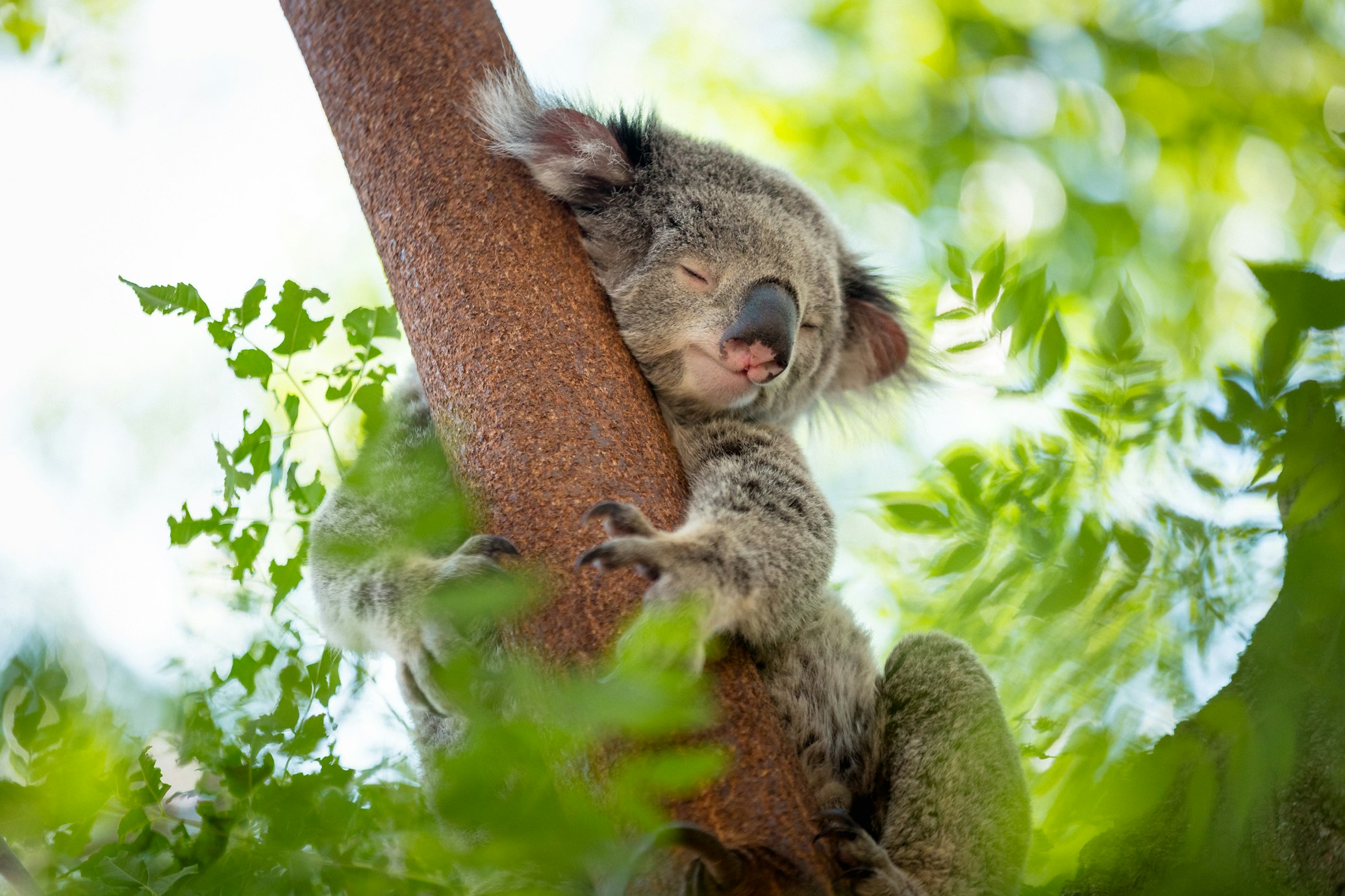Anatomical, Behavioural and Physiological Adaptations of the Koala (Phascolarctos cinereus) to a Eucalyptus Dominated Diet
Introduction
Koalas (Phascolarctos cinereus) are arboreal marsupial florivores endemic to Australia’s tropical and subtropical forests (Martin and Handasyde 1999). Occupying a narrow ecological niche has virtually eliminated intraspecific competition and, by extension, ensured the success of the species. Their survival is largely attributed to their capacity to metabolise a diet dominated by eucalyptus foliage; a poor quality, high fibre feed (Cork and Warner 1983; Martin and Handasyde 1999; Moore and Foley 2000).
Making use of poor food.
There are considerable anatomical, behavioural and physiological adaptations involved with feeding almost exclusively on eucalyptus foliage. Perhaps the most significant anatomical adaptation of the Koala involves the evolutionary enlargement of the caecum. In koalas, this sac like feature accounts for 10% of their body mass (Grand and Barboza 2001) and is critical to the fermentation of undigested fibrous matter (Harrop and Degabriele 1976). The increased volume provided by a such a large projection is paramount to the retention of digestible particles and water, providing an increased capacity to ferment and later absorb energy dense carbohydrates from digesta (Harrop and Degabriele 1976).
Similarly, it is postulated that a symbiotic relationship exists between koalas and the microflora which inhabit their gastrointestinal tract (Cork, Hume and Dawson 1983). It is thought that the breakdown of dietary cell walls into their constituent carbohydrates is greatly facilitated by extensive microbial activity (Cork and Warner 1983). This significantly increases the rate at which complex carbohydrates can be absorbed and utilised by koalas. A logical extension of this relationship suggests that koalas also metabolise a small portion of their microflora, thus obtaining a source of microbial protein (Cork 1986).
Reducing energy needs.
Optimising energetic returns of feed is of great importance to Koalas, however, they must also meet nutritional requirements for other macromolecules. Research highlights a behavioural adaptation whereby Koalas have a tendency to prefer browsing young eucalyptus foliage where available (Hindell 1984; Moore and Foley 2000). Young eucalyptus leaves contain less fibre making them more readily digestible, but it is the increased crude protein content that koalas appear to seek (Moore and Foley 2000).
The ability of Koalas to survive on low quality foliages is aided by physiological and behavioural adaptations that serve to minimise their energy requirements (Cork 1986). Their dense pelt insulates them from the external environment, drastically reducing the physiological buffering needed to maintain a constant, albeit depressed, core body temperature (Degabriele and Dawson 1979). Similarly, koalas have a reduced basal metabolic rate which lessens the energy burden associated with maintaining homeostasis within the body environment (Degabriele and Dawson 1979). Furthermore, a large proportion of their time is spent resting in the forest canopy where they digest, with little unnecessary movement; bouts of physical exertion are typically intense and energy demanding, but brief (Grand and Barboza 2001).
Conclusion
Although greatly reduced, the energy demands of koalas must still be met if the individual is to survive. It can be concluded that the highly specialised digestive tract, physiology and seemingly lethargic behaviour of the koala are all important evolutionary adaptations that work in concert to ensure they not only survive, but thrive in an ecological niche that at first sight appears inhospitable.
Bibliography
Cork, SJ 1986, ‘Foliage of eucalyptus-punctata and the maintenance nitrogen requirements of koalas, phascolarctos-cinereus’, Australian Journal of Zoology, vol. 34, no. 1, pp. 17-23.
Cork, SJ, Hume, I & Dawson, T 1983, ‘Digestion and metabolism of a natural foliar diet (eucalyptus punctata) by an arboreal marsupial, the koala (phascolarctos cinereus)’, Journal of Comparative Physiology, vol. 153, no. 2, pp. 181-190.
Cork, SJ & Warner, A 1983, ‘The passage of digesta markers through the gut of a folivorous marsupial, the koalaphascolarctos cinereus’, Journal of comparative physiology, vol. 152, no. 1, pp. 43-51.
Degabriele, R & Dawson, T 1979, ‘Metabolism and heat balance in an arboreal marsupial, the koala (phascolarctos cinereus)’, Journal of Comparative Physiology B: Biochemical, Systemic, and Environmental Physiology, vol. 134, no. 4, pp. 293-301.
Grand, TI & Barboza, PS 2001, ‘Anatomy and development of the koala, phascolarctos cinereus: An evolutionary perspective on the superfamily vombatoidea’, Anatomy and embryology, vol. 203, no. 3, pp. 211-223.
Harrop, C & Degabriele, R 1976, ‘Digestion and nitrogen metabolism in the koala, phascolarctos cinereus’, Australian Journal of Zoology, vol. 24, no. 2, pp. 201-215.
Hindell, MA 1984, The feeding ecology of the koala, phascolarctos cinereus, in a mixed eucalyptus forest, Monash University.
Martin, RW & Handasyde, KA 1999, The koala: Natural history, conservation and management, UNSW press.
Moore, BD & Foley, WJ 2000, ‘A review of feeding and diet selection in koalas (phascolarctos cinereus)’, Australian Journal of Zoology, vol. 48, no. 3, pp. 317-333.

